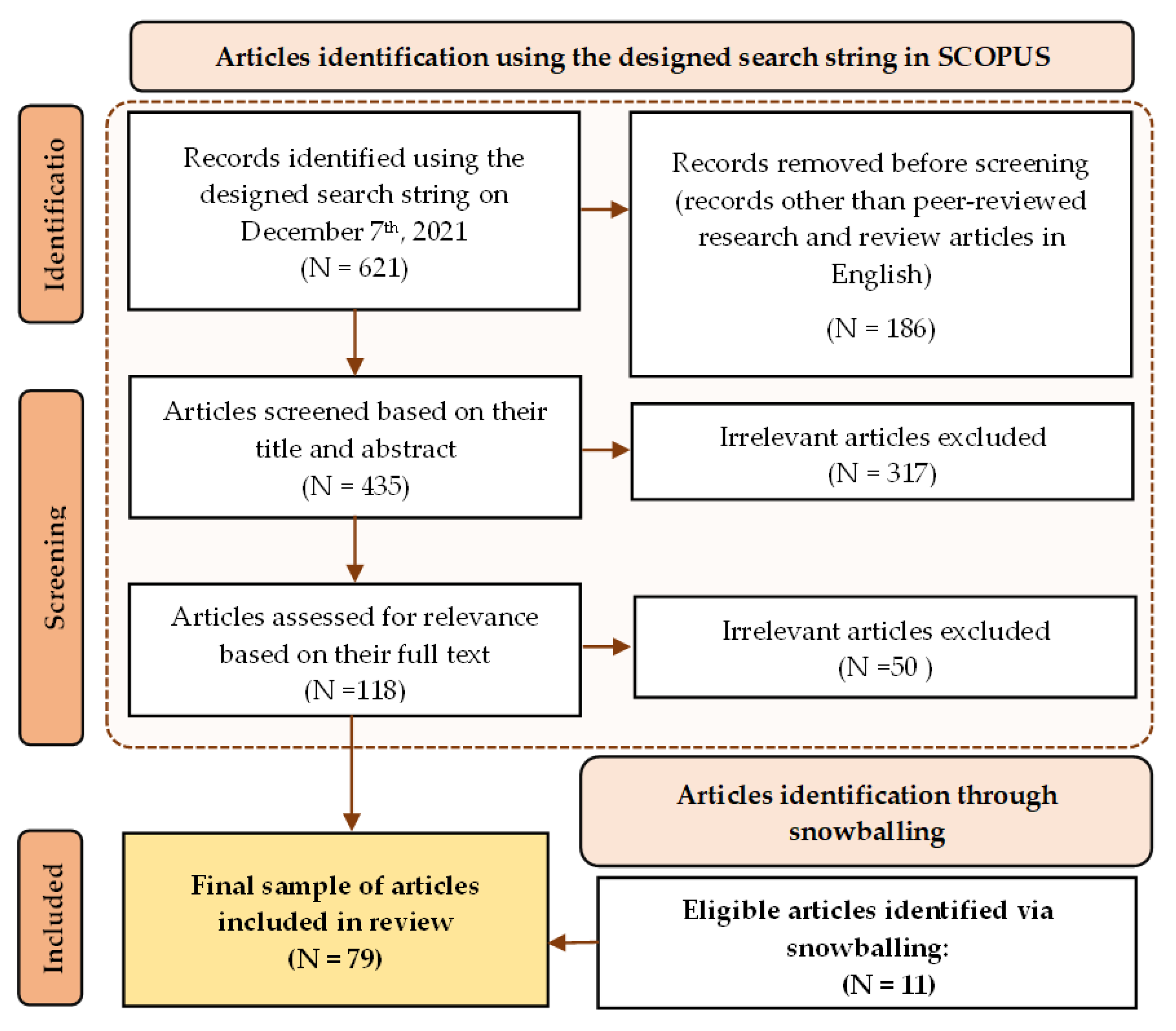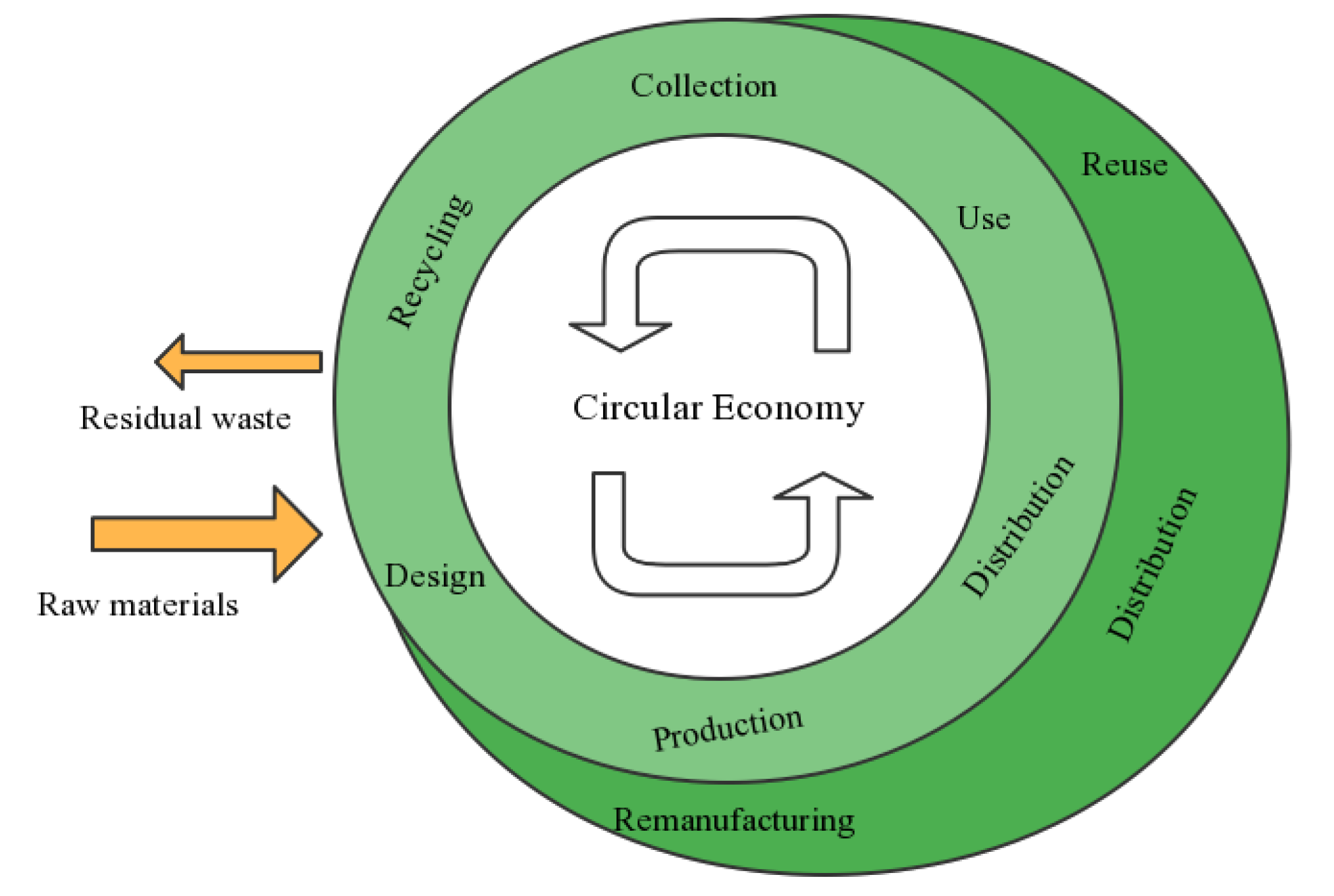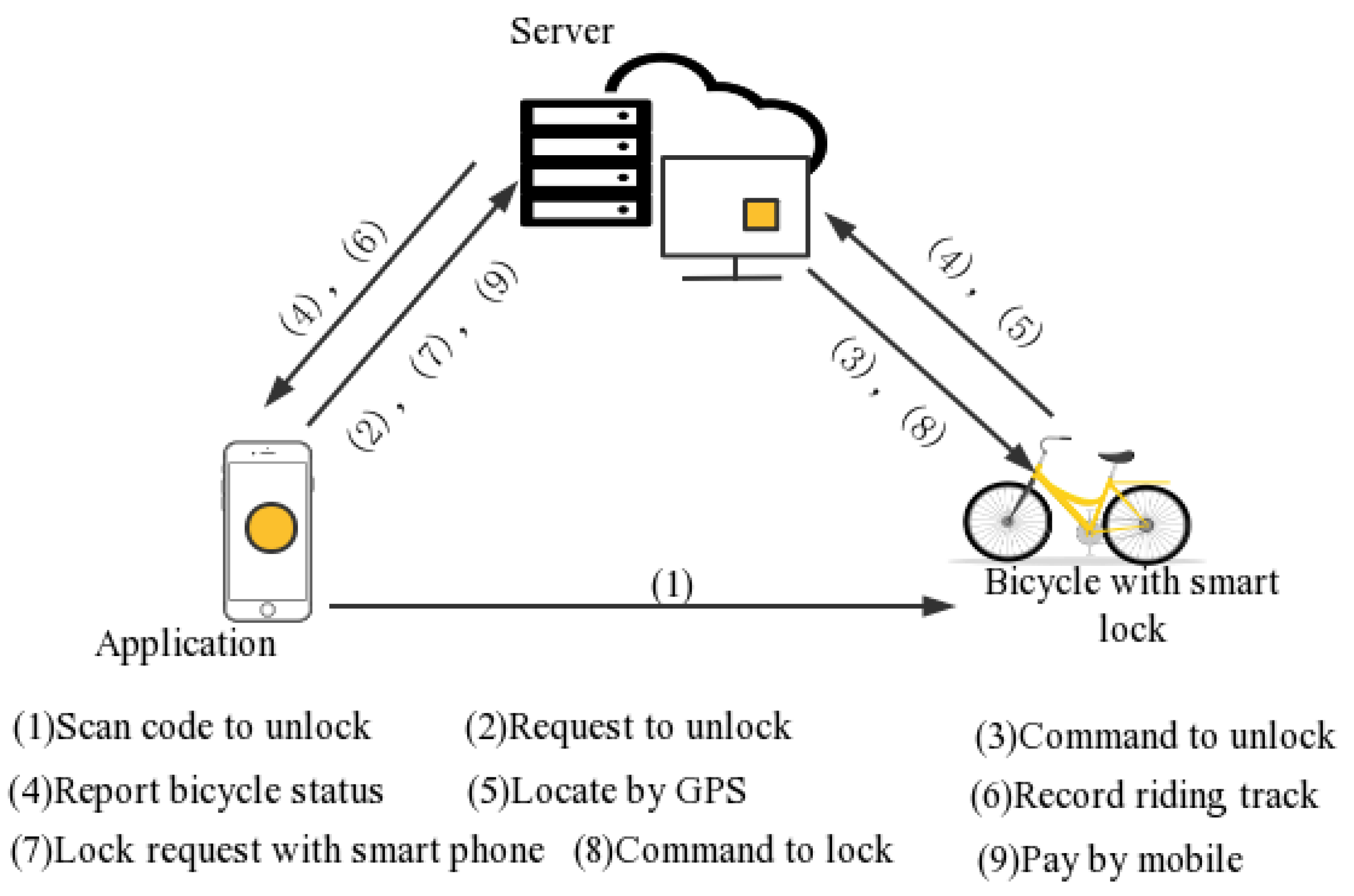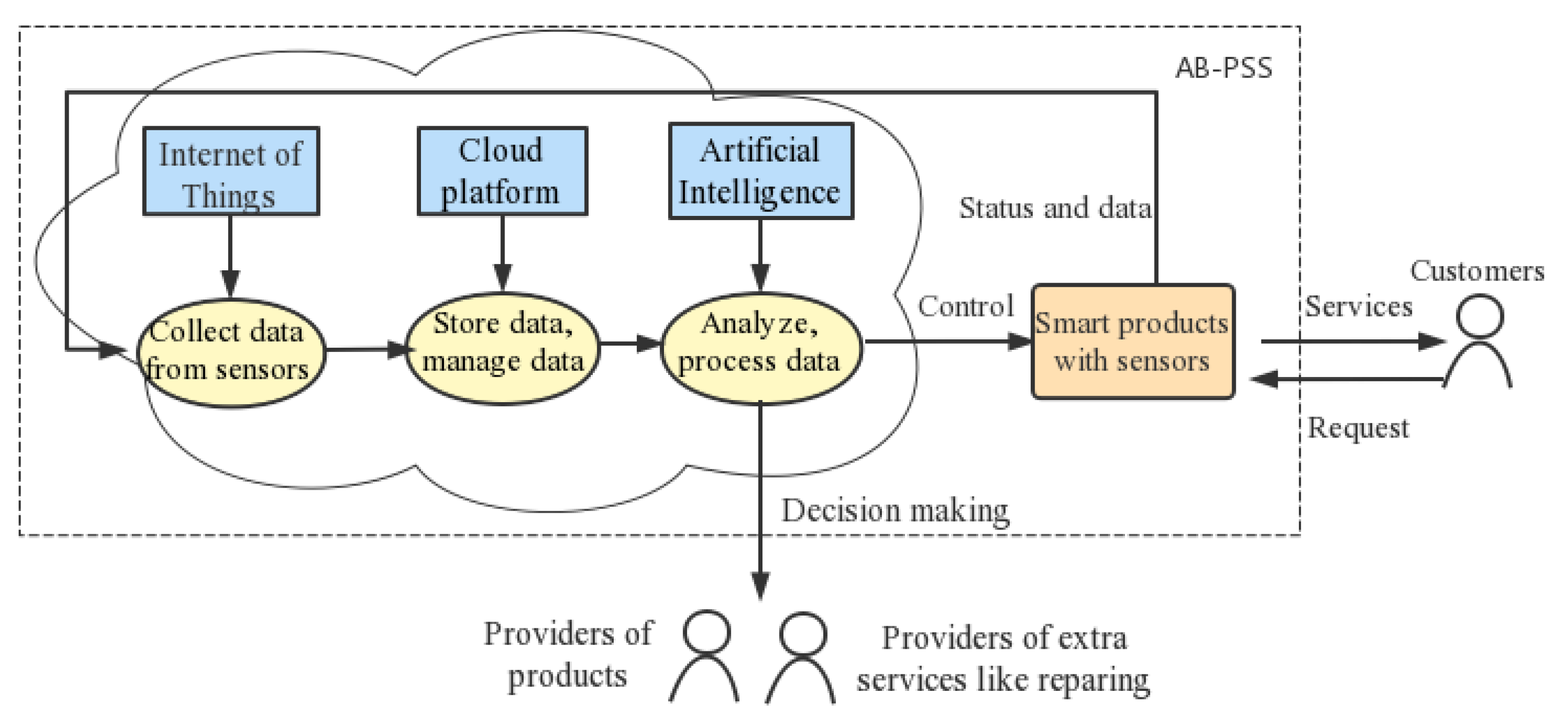Exploring How Digital Technologies Enable a Circular Economy of Products
Abstract
1. Introduction
2. Research Methodology
- Search in title: “circular econom*” OR “circular bioeconom*” OR “circular bio-econom*” OR “circular bio econom*” OR “circular trans*” OR “closed loop supply” OR “closed-loop supply” OR “circular business*”
- Search in title, abstracts, and keywords: “intelligent technolog*” OR “smart technolog*” OR “digital technolog*” OR “digitaliz*” OR “digitally-enabled technolog*” OR “digital business*” OR “digital twin*” OR “Industry 4.0” OR “I4.0” OR “Internet of things” OR “IoT” OR “big data” OR “artificial intelligence” OR “blockchain” OR “ICT” OR “information and communications technolog*” OR “cyber physical system*” OR “machine learning”.
3. Literature Review
3.1. Circular Economy as a New Industrial Paradigm
3.2. Innovations in Business Models
3.3. Role of Industry 4.0 in CE
4. Results: Exploring the Conceptual Framework of DTs in the CE in Terms of Product Lifecycle
4.1. Product Design
4.2. Product Use
4.3. Product Recovery
5. Application and Discussion
Reflections on a Bike-Sharing Platform as an Example of AB-PSSs
6. Conclusions
Author Contributions
Funding
Institutional Review Board Statement
Informed Consent Statement
Data Availability Statement
Acknowledgments
Conflicts of Interest
Abbreviations
| DTs | digital technologies; |
| CE | circular economy; |
| AB-PSS | access-based product-service system; |
| IoT | Internet of things; |
| CPS | cyber-physical systems; |
| AI | artificial intelligence; |
| GPS | global positioning system. |
References
- Geissdoerfer, M.; Savaget, P.; Bocken, N.M.; Hultink, E.J. The circular economy–a new sustainability paradigm? J. Clean. Prod. 2017, 143, 757–768. [Google Scholar] [CrossRef]
- Ghisellini, P.; Cialani, C.; Ulgiati, S. A review on circular economy: The expected transition to a balanced interplay of environmental and economic systems. J. Clean. Prod. 2016, 114, 11–32. [Google Scholar] [CrossRef]
- Ellen MacArthur Foundation. Towards the Circular Economy: Economic and Business Rationale for an Accelerated Transition; EMF: Cowes, UK, 2013; Volume 1. [Google Scholar]
- Ellen MacArthur Foundation. Artificial Intelligence and the Circular Economy; EMF: Cowes, UK, 2019. [Google Scholar]
- Irani, Z.; Sharif, A.M. Food security across the enterprise: A puzzle, problem or mess for a circular economy? J. Enterp. Inf. Manag. 2018, 31, 2–9. [Google Scholar] [CrossRef]
- Rajput, S.; Singh, S.P. Connecting circular economy and industry 4.0. Int. J. Inf. Manag. 2019, 49, 98–113. [Google Scholar] [CrossRef]
- Ranta, V.; Aarikka-Stenroos, L.; Väisänen, J.M. Digital technologies catalyzing business model innovation for circular economy—Multiple case study. Resour. Conserv. Recycl. 2021, 164, 105155. [Google Scholar] [CrossRef]
- Bressanelli, G.; Adrodegari, F.; Perona, M.; Saccani, N. Exploring how usage-focused business models enable circular economy through digital technologies. Sustainability 2018, 10, 639. [Google Scholar] [CrossRef]
- Rosa, P.; Sassanelli, C.; Urbinati, A.; Chiaroni, D.; Terzi, S. Assessing relations between circular economy and industry 4.0: A systematic literature review. Int. J. Prod. Res. 2020, 58, 1662–1687. [Google Scholar] [CrossRef]
- Pham, T.T.; Kuo, T.-C.; Tseng, M.-L.; Tan, R.R.; Tan, K.; Ika, D.S.; Lin, C.J. Industry 4.0 to accelerate the circular economy: A case study of electric scooter sharing. Sustainability 2019, 11, 6661. [Google Scholar] [CrossRef]
- Dev, N.K.; Shankar, R.; Qaiser, F.H. Industry 4.0 and circular economy: Operational excellence for sustainable reverse supply chain performance. Resour. Conserv. Recycl. 2020, 153, 104583. [Google Scholar] [CrossRef]
- Yadav, G.; Luthra, S.; Jakhar, S.K.; Mangla, S.K.; Rai, D.P. A framework to overcome sustainable supply chain challenges through solution measures of industry 4.0 and circular economy: An automotive case. J. Clean. Prod. 2020, 254, 120112. [Google Scholar] [CrossRef]
- Pieroni, M.P.; McAloone, T.C.; Pigosso, D.C. Business model innovation for circular economy and sustainability: A review of approaches. J. Clean. Prod. 2019, 215, 198–216. [Google Scholar] [CrossRef]
- Ingemarsdotter, E.; Jamsin, E.; Kortuem, G.; Balkenende, R. Circular strategies enabled by the internet of things—A framework and analysis of current practice. Sustainability 2019, 11, 5689. [Google Scholar] [CrossRef]
- Guzzo, D.; Trevisan, A.H.; Echeveste, M.; Costa, J.M.H. Circular innovation framework: Verifying conceptual to practical decisions in sustainability-oriented product-service system cases. Sustainability 2019, 11, 3248. [Google Scholar] [CrossRef]
- Alcayaga, A.; Wiener, M.; Hansen, E.G. Towards a framework of smart-circular systems: An integrative literature review. J. Clean. Prod. 2019, 221, 622–634. [Google Scholar] [CrossRef]
- Kristoffersen, E.; Blomsma, F.; Mikalef, P.; Li, J. The smart circular economy: A digital-enabled circular strategies framework for manufacturing companies. J. Bus. Res. 2020, 120, 241–261. [Google Scholar] [CrossRef]
- Grafström, J.; Aasma, S. Breaking circular economy barriers. J. Clean. Prod. 2021, 292, 126002. [Google Scholar] [CrossRef]
- Abdul-Hamid, A.-Q.; Ali, M.H.; Tseng, M.-L.; Lan, S.; Kumar, M. Impeding challenges on industry 4.0 in circular economy: Palm oil industry in Malaysia. Comput. Oper. Res. 2020, 123, 105052. [Google Scholar] [CrossRef]
- Okorie, O.; Salonitis, K.; Charnley, F.; Moreno, M.; Turner, C.; Tiwari, A. Digitisation and the circular economy: A review of current research and future trends. Energies 2018, 11, 3009. [Google Scholar] [CrossRef]
- Alcayaga, A.; Hansen, E.G. Smart products as enabler for circular business models: The case of B2B textile washing services. In Proceedings of the 3rd PLATE 2019 Conference, Berlin, Germany, 18–20 September 2019; pp. 18–20. [Google Scholar]
- Bocken, N.M.; Mugge, R.; Bom, C.A.; Lemstra, H.J. Pay-per-use business models as a driver for sustainable consumption: Evidence from the case of HOMIE. J. Clean. Prod. 2018, 198, 498–510. [Google Scholar] [CrossRef]
- Cagno, E.; Neri, A.; Negri, M.; Bassani, C.A.; Lampertico, T. The role of digital technologies in operationalizing the circular economy transition: A systematic literature review. Appl. Sci. 2021, 11, 3328. [Google Scholar] [CrossRef]
- Flaherty, T.; Domegan, C.; Anand, M. The use of digital technologies in social marketing: A systematic review. J. Soc. Mark. 2021, 11, 378–405. [Google Scholar] [CrossRef]
- Mushi, G.E.; Di Marzo Serugendo, G.; Burgi, P.Y. Digital technology and services for sustainable agriculture in Tanzania: A literature review. Sustainability 2022, 14, 2415. [Google Scholar] [CrossRef]
- Pirola, F.; Boucher, X.; Wiesner, S.; Pezzotta, G. Digital technologies in product-service systems: A literature review and a research agenda. Comput. Ind. 2020, 123, 103301. [Google Scholar] [CrossRef]
- Liberati, A.; Altman, D.G.; Tetzlaff, J.; Mulrow, C.; Gøtzsche, P.C.; Ioannidis, J.P.A.; Clarke, M.; Devereaux, P.J.J.; Kleijnen, J.; Moher, D. The PRISMA statement for reporting systematic reviews and meta-analyses of studies that evaluate health care interventions: Explanation and elaboration. J. Clin. Epidemiol. 2009, 62, e1–e34. [Google Scholar] [CrossRef] [PubMed]
- Page, M.J.; McKenzie, J.E.; Bossuyt, P.M.; Boutron, I.; Hoffmann, T.C.; Mulrow, C.D.; Shamseer, L.; Tetzlaff, J.M.; Akl, E.A.; Brennan, S.E.; et al. The PRISMA 2020 statement: An updated guideline for reporting systematic reviews. BMJ 2021, 10, 89. [Google Scholar] [CrossRef]
- Ellen MacArthur Foundation. What Is a Circular Economy? 2013. Available online: https://www.ellenmacarthurfoundation.org/circular-economy/infographic (accessed on 14 April 2021).
- Franco, M.A. Circular economy at the micro level: A dynamic view of incumbents’ struggles and challenges in the textile industry. J. Clean. Prod. 2017, 168, 833–845. [Google Scholar] [CrossRef]
- Geng, Y.; Doberstein, B. Developing the circular economy in China: Challenges and opportunities for achieving ‘leapfrog development’. Int. J. Sustain. Dev. World Ecol. 2008, 15, 231–239. [Google Scholar] [CrossRef]
- Murray, A.; Skene, K.; Haynes, K. The circular economy: An interdisciplinary exploration of the concept and application in a global context. J. Bus. Ethics 2017, 140, 369–380. [Google Scholar] [CrossRef]
- Bilitewski, B. The circular economy and its risks. J. Waste Manag. 2012, 1, 1–2. [Google Scholar] [CrossRef]
- Spring, M.; Araujo, L. Product biographies in servitization and the circular economy. Ind. Mark. Manag. 2017, 60, 126–137. [Google Scholar] [CrossRef]
- Go, T.F.; Wahab, D.A.; Hishamuddin, H. Multiple generation life-cycles for product sustainability: The way forward. J. Clean. Prod. 2015, 95, 16–29. [Google Scholar] [CrossRef]
- Mont, O. Innovative approaches to optimising design and use of durable consumer goods. Int. J. Prod. Dev. 2008, 6, 227. [Google Scholar] [CrossRef]
- Bakker, C.; Wang, F.; Huisman, J.; Den Hollander, M. Products that go round: Exploring product life extension through design. J. Clean. Prod. 2014, 69, 10–16. [Google Scholar] [CrossRef]
- Nobre, G.C.; Tavares, E. Scientific literature analysis on big data and internet of things applications on circular economy: A bibliometric study. Scientometrics 2017, 111, 463–492. [Google Scholar] [CrossRef]
- Van Loon, P.; Van Wassenhove, L.N. Assessing the economic and environmental impact of remanufacturing: A decision support tool for OEM suppliers. Int. J. Prod. Res. 2018, 56, 1662–1674. [Google Scholar] [CrossRef]
- Teece, D.J. Business models, business strategy and innovation. Long Range Plan. 2010, 43, 172–194. [Google Scholar] [CrossRef]
- Richard, W.; Peter, B. Go Downstream: The New Profit Imperative in Manufacturing. Harv. Bus. Rev. 1999, 77, 41. [Google Scholar]
- Michelini, R.; Razzoli, R. Product-service for environmental safeguard: A metrics to sustainability. Resour. Conserv. Recycl. 2004, 42, 83–98. [Google Scholar] [CrossRef]
- Bocken, N.M.; De Pauw, I.; Bakker, C.; Van Der Grinten, B. Product design and business model strategies for a circular economy. J. Ind. Prod. Eng. 2016, 33, 308–320. [Google Scholar] [CrossRef]
- Dimache, A.; Roche, T. A decision methodology to support servitisation of manufacturing. Int. J. Oper. Prod. Manag. 2013, 33, 1435–1457. [Google Scholar] [CrossRef]
- Tukker, A. Eight types of product–service system: Eight ways to sustainability? Experiences from SusProNet. Bus. Strategy Environ. 2004, 13, 246–260. [Google Scholar] [CrossRef]
- Morlet, A.; Blériot, J.; Opsomer, R.; Linder, M.; Henggeler, A.; Bluhm, A.; Carrera, A. Intelligent Assets: Unlocking the Circular Economy Potential; Ellen MacArthur Foundation: Cowes, UK, 2016. [Google Scholar]
- Valencia, A.; Mugge, R.; Schoormans, J.; Schifferstein, H. The design of smart product-service systems (PSSs): An exploration of design characteristics. Int. J. Des. 2015, 9, 13–28. [Google Scholar]
- Baines, T.; Lightfoot, H.W. Servitization of the manufacturing firm: Exploring the operations practices and technologies that deliver advanced services. Int. J. Oper. Prod. Manag. 2014, 34, 2–35. [Google Scholar] [CrossRef]
- Reim, W.; Parida, V.; Örtqvist, D. Product–Service Systems (PSS) business models and tactics–a systematic literature review. J. Clean. Prod. 2015, 97, 61–75. [Google Scholar] [CrossRef]
- Kujala, S.; Artto, K.; Aaltonen, P.; Turkulainen, V. Business models in project-based firms–Towards a typology of solution-specific business models. Int. J. Proj. Manag. 2010, 28, 96–106. [Google Scholar] [CrossRef]
- Adrodegari, F.; Saccani, N. Business models for the service transformation of industrial firms. Serv. Ind. J. 2017, 37, 57–83. [Google Scholar] [CrossRef]
- Trevisan, A.H.; Zacharias, I.S.; Liu, Q.; Yang, M.; Mascarenhas, J. Circular economy and digital technologies: A review of the current research streams. Proc. Des. Soc. 2021, 1, 621–630. [Google Scholar] [CrossRef]
- Rajput, S.; Singh, S.P. Industry 4.0 Model for circular economy and cleaner production. J. Clean. Prod. 2020, 277, 123853. [Google Scholar] [CrossRef]
- Rüßmann, M.; Lorenz, M.; Gerbert, P.; Waldner, M.; Justus, J.; Engel, P.; Harnisch, M. Industry 4.0: The Future of Productivity and Growth in Manufacturing Industries; Boston Consulting Group: Boston, MA, USA, 2015; pp. 54–89. [Google Scholar]
- Bag, S.; Gupta, S.; Kumar, S. Industry 4.0 adoption and 10R advance manufacturing capabilities for sustainable development. Int. J. Prod. Econ. 2021, 231, 107844. [Google Scholar] [CrossRef]
- Paton, S.; Ates, A.; Sminia, H.; Smith, M. Making sense of high value manufacturing: Relating policy and theory. Prod. Plan. Control 2021, 1–12. [Google Scholar] [CrossRef]
- Li, L. China’s manufacturing locus in 2025: With a comparison of “Made-in-China 2025” and “Industry 4.0”. Technol. Forecast. Soc. Change 2018, 135, 66–74. [Google Scholar] [CrossRef]
- Lee, J.; Davari, H.; Singh, J.; Pandhare, V. Industrial Artificial Intelligence for industry 4.0-based manufacturing systems. Manuf. Lett. 2018, 18, 20–23. [Google Scholar] [CrossRef]
- Liu, M.; Ma, J.; Lin, L.; Ge, M.; Wang, Q.; Liu, C. Intelligent assembly system for mechanical products and key technology based on internet of things. J. Intell. Manuf. 2017, 28, 271–299. [Google Scholar] [CrossRef]
- Dubey, R.; Gunasekaran, A.; Papadopoulos, T.; Childe, S.J.; Shibin, K.; Wamba, S.F. Sustainable supply chain management: Framework and further research directions. J. Clean. Prod. 2017, 142, 1119–1130. [Google Scholar] [CrossRef]
- Agrawal, R.; Wankhede, V.A.; Kumar, A.; Luthra, S.; Huisingh, D. Progress and trends in integrating Industry 4.0 within Circular Economy: A comprehensive literature review and future research propositions. Bus. Strategy Environ. 2022, 31, 559–579. [Google Scholar] [CrossRef]
- Abdul-Hamid, A.Q.; Ali, M.H.; Osman, L.H.; Tseng, M.L.; Lim, M.K. Industry 4.0 quasi-effect between circular economy and sustainability: Palm oil industry. Int. J. Prod. Econ. 2022, 253, 108616. [Google Scholar] [CrossRef]
- Çetin, S.; Gruis, V.; Straub, A. Digitalization for a circular economy in the building industry: Multiple-case study of Dutch social housing organizations. Resour. Conserv. Recycl. 2022, 15, 200110. [Google Scholar] [CrossRef]
- Kalogiannidis, S.; Kalfas, D.; Chatzitheodoridis, F.; Kontsas, S. The Impact of Digitalization in Supporting the Performance of Circular Economy: A Case Study of Greece. J. Risk Financ. Manag. 2022, 15, 349. [Google Scholar] [CrossRef]
- Ahmed, A.A.; Nazzal, M.A.; Darras, B.M. Cyber-physical systems as an enabler of circular economy to achieve sustainable development goals: A comprehensive review. Int. J. Precis. Eng. Manuf. -Green Technol. 2022, 9, 955–975. [Google Scholar] [CrossRef]
- Chauhan, C.; Parida, V.; Dhir, A. Linking circular economy and digitalisation technologies: A systematic literature review of past achievements and future promises. Technol. Forecast. Soc. Change 2022, 177, 121508. [Google Scholar] [CrossRef]
- Rakhshan, K.; Morel, J.C.; Daneshkhah, A. Predicting the technical reusability of load-bearing building components: A probabilistic approach towards developing a Circular Economy framework. J. Build. Eng. 2021, 42, 102791. [Google Scholar] [CrossRef]
- Uribe-Toril, J.; Ruiz-Real, J.L.; Galindo Durán, A.C.; Torres Arriaza, J.A.; de Pablo Valenciano, J. The Circular Economy and retail: Using Deep Learning to predict business survival. Environ. Sci. Eur. 2022, 34, 2. [Google Scholar] [CrossRef]
- Arranz, C.F.; Sena, V.; Kwong, C. Institutional pressures as drivers of circular economy in firms: A machine learning approach. J. Clean. Prod. 2022, 355, 131738. [Google Scholar] [CrossRef]
- de Sousa Jabbour, A.B.L.; Jabbour, C.J.C.; Choi, T.M.; Latan, H. ‘Better together’: Evidence on the joint adoption of circular economy and industry 4.0 technologies. Int. J. Prod. Econ. 2022, 252, 108581. [Google Scholar] [CrossRef]
- Kurniawan, T.A.; Othman, M.H.D.; Hwang, G.H.; Gikas, P. Unlocking digital technologies for waste recycling in industry 4.0 era: A transformation towards a digitalization-based circular economy in Indonesia. J. Clean. Prod. 2022, 357, 131911. [Google Scholar] [CrossRef]
- Delpla, V.; Kenné, J.P.; Hof, L.A. Circular manufacturing 4.0: Towards internet of things embedded closed-loop supply chains. Int. J. Adv. Manuf. Technol. 2022, 118, 3241–3264. [Google Scholar] [CrossRef]
- Rusch, M.; Schöggl, J.P.; Baumgartner, R.J. Application of digital technologies for sustainable product management in a circular economy: A review. Bus. Strategy Environ. 2021, 1–16. [Google Scholar] [CrossRef]
- Talla, A.; McIlwaine, S. Industry 4.0 and the circular economy: Using design-stage digital technology to reduce construction waste. Smart Sustain. Built Environ. 2022; ahead-of-print. [Google Scholar] [CrossRef]
- Shevchenko, T.; Danko, Y. Circular Data Framework throughout the Whole Value Chain from Mining to Manufacturing, from Refurbishing to Recycling. In Role of Circular Economy in Resource Sustainability; Springer Nature: Cham, Switzerland, 2022; Volume VII, pp. 7–16. [Google Scholar] [CrossRef]
- Patyal, V.S.; Sarma, P.; Modgil, S.; Nag, T.; Dennehy, D. Mapping the links between industry 4.0, circular economy and sustainability: A systematic literature review. J. Adv. Manuf. Technol. 2022, 35, 1–35. [Google Scholar] [CrossRef]
- Medkova, K.; Fifield, B. Circular Design—Design for Circular Economy; Lahti Cleantech Annual Review; Lahti University of Applied Sciences: Lahti, Finland, 2016; p. 32. [Google Scholar]
- Krstić, M.; Agnusdei, G.P.; Miglietta, P.P.; Tadić, S.; Roso, V. Applicability of Industry 4.0 Technologies in the Reverse Logistics: A Circular Economy Approach Based on Comprehensive Distance Based Ranking (COBRA) Method. Sustainability 2022, 14, 5632. [Google Scholar] [CrossRef]
- Neligan, A.; Baumgartner, R.J.; Geissdoerfer, M.; Schöggl, J.P. Circular disruption: Digitalisation as a driver of circular economy business models. Bus. Strategy Environ. 2022. [Google Scholar] [CrossRef]
- Rosen, D.W. Thoughts on design for intelligent manufacturing. Engineering 2019, 5, 609–614. [Google Scholar] [CrossRef]
- Shevchenko, T.; Saidani, M.; Danko, Y.; Golysheva, I.; Chovancová, J.; Vavrek, R. Towards a smart E-waste system utilizing supply chain participants and interactive online maps. Recycling 2021, 6, 8. [Google Scholar] [CrossRef]
- Han, Y.; Shevchenko, T.; Qu, D. Smart E-waste Management in China: A Review. In Congress on Intelligent Systems; Springer: Singapore, 2022; pp. 515–533. [Google Scholar] [CrossRef]
- Kang, K.D.; Kang, H.; Ilankoon, I.; Chong, C.Y. Electronic waste collection systems using Internet of Things (IoT): Household electronic waste management in Malaysia. J. Clean. Prod. 2020, 252, 119801. [Google Scholar] [CrossRef]
- Fayomi, G.U.; Mini, S.E.; Chisom, C.M.; Fayomi, O.S.I.; Udoye, N.E.; Agboola, O.; Oomole, D. Smart Waste Management for Smart City: Impact on Industrialization. IOP Conf. Ser. Earth Environ. Sci. 2020, 655, 012040. Available online: https://iopscience.iop.org/issue/1755-1315/655/1 (accessed on 27 March 2021). [CrossRef]
- Gupta, P.K.; Shree, V.; Hiremath, L.; Rajendran, S. The use of modern technology in smart waste management and recycling: Artificial intelligence and machine learning. In Recent Advances in Computational Intelligence; Springer: Cham, Switzerland, 2019; pp. 173–188. [Google Scholar]
- Lenka, S.; Parida, V.; Wincent, J. Digitalization capabilities as enablers of value co-creation in servitizing firms. Psychol. Mark. 2017, 34, 92–100. [Google Scholar] [CrossRef]
- Porter, M.E.; Heppelmann, J.E. How smart, connected products are transforming competition. Harv. Bus. Rev. 2014, 92, 64–88. [Google Scholar]
- Curtis, S.K.; Lehner, M. Defining the sharing economy for sustainability. Sustainability 2019, 11, 567. [Google Scholar] [CrossRef]
- Pouri, M.J.; Hilty, L.M. Digitally enabled sharing and the circular economy: Towards a framework for sustainability assessment. In Advances and New Trends in Environmental Informatics; Springer: Cham, Switzerland, 2020; pp. 105–116. [Google Scholar]
- Esfandabadi, Z.S.; Diana, M.; Zanetti, M.C. Carsharing services in sustainable urban transport: An inclusive science map of the field. J. Clean. Prod. 2022, 357, 131981. [Google Scholar] [CrossRef]
- Belk, R. Sharing versus pseudo-sharing in Web 2.0. Anthropologist 2014, 18, 7–23. [Google Scholar] [CrossRef]
- Bocken, N.; Ingemarsdotter, E.; Gonzalez, D. Designing sustainable business models: Exploring IoT-enabled strategies to drive sustainable consumption. In Sustainable Business Models; Springer: Cham, Switzerland, 2019; pp. 61–88. [Google Scholar]
- Tunn, V.; Van den Hende, E.; Bocken, N.; Schoormans, J. Digitalised product-service systems: Effects on consumers’ attitudes and experiences. Resour. Conserv. Recycl. 2020, 162, 105045. [Google Scholar] [CrossRef]
- Fishman, E. Bikeshare: A review of recent literature. Transp. Rev. 2016, 36, 92–113. [Google Scholar] [CrossRef]
- Adrodegari, F.; Saccani, N.; Kowalkowski, C.; Vilo, J. PSS business model conceptualization and application. Prod. Plan. Control 2017, 28, 1251–1263. [Google Scholar] [CrossRef]
- Shen, S.; Wei, Z.Q.; Sun, L.J.; Su, Y.Q.; Wang, R.C.; Jiang, H.M. The shared bicycle and its network—Internet of shared bicycle (IOSB): A review and survey. Sensors 2018, 18, 2581. [Google Scholar] [CrossRef] [PubMed]
- Kim, H.; Cluzel, F.; Leroy, Y.; Yannou, B.; Yannou-Le Bris, G. Research perspectives in ecodesign. Des. Sci. 2020, 6, e7. [Google Scholar] [CrossRef]
- Rymaszewska, A.; Helo, P.; Gunasekaran, A. IoT powered servitization of manufacturing–an exploratory case study. Int. J. Prod. Econ. 2017, 192, 92–105. [Google Scholar] [CrossRef]
- Bouillass, G.; Saidani, M.; Lameh, J.; Yannou, B. Digital technologies to advance circular economy at territorial level: Challenges and solutions. In Proceedings of the IEEE 28th ICE/ITMC & 31st IAMOT Joint Conference, Nancy, France, 19–23 June 2022; Available online: https://ice-iamot-2022-conference.org/ (accessed on 27 July 2022).
- Hein, A.M.; Jankovic, M.; Feng, W.; Farel, R.; Yune, J.H.; Yannou, B. Stakeholder power in industrial symbioses: A stakeholder value network approach. J. Clean. Prod. 2017, 148, 923–933. [Google Scholar] [CrossRef]







| Product–Service Business Model | Ownership of the Product | Advantages Regarding the CE | Main Drawbacks Regarding the CE | Corresponding References |
|---|---|---|---|---|
| Product-oriented business model | Customers | The enterprises will provide pre-sale services and corresponding after-sale services | Negative environmental impacts of products, which will probably become wastes | [40,42,45,48] |
| Use-oriented business model | Enterprises | It avoids the risk of customers holding a large number of fixed assets, increases product utilization rates, and creates additional economic value | Difficult to measure remanufacturing and reconditioning activities and short lifetime of some user-oriented products | [40,42,43,44,45,46,47,48,49,50,51] |
| Result-oriented business model | Enterprises | Customers are provided with the highest degree of service, which can make customers directly evaluate the effect of service and can help enterprises transition to a CE | Difficult to measure results in terms of product/system performance | [40,42,45,47,48,49] |
| Design-for-x Strategies | Analysis of the Strategies | CE Performance Objectives | Function of Digital Technologies |
|---|---|---|---|
| Design for manufacturing | Design for manufacturing helps save resources in product manufacturing and enables rapid high-quality manufacturing | Use fewer materials and resources | Digital design and manufacturing technology provide product design solutions that integrate many advanced technologies, such as CAD/CAPP/CAM |
| Design for assembly | Design for assembly helps improve efficiency and reduce wear during product assembly | Extend product lifespan | Digital assembly technology uses virtual reality to plan and simulate the actual product assembly process |
| Design for disassembly | Design for disassembly allows rapid product disassembly, improves reparability, and reduces consumable input and waste output | Close the loop | The virtual disassembly method based on a 3D software platform can guide the product disassembly process |
| Design for quality | Achieving high-quality product design helps improve product quality to meet customer needs | Extend product lifespan | Digital prototyping technology can be used to improve product function |
| Design for supply chain management | Designs that consider supply chain-related factors can help improve product efficiency and reduce instability in the supply chain | Use fewer materials and resources | Blockchain and Internet of things technologies can be used to establish a product supply chain traceability system |
| Design for lifecycle | Considering the product lifecycle in the design helps assess overall resources consumed and pollution generated in the product lifecycle | Use fewer materials and resources | Virtual manufacturing systems based on digital twin technology consider all important factors at each stage of the product lifecycle |
| Design for the environment | Considering environmental impacts in product design helps achieve sustainability goals | Close the loop | Additive manufacturing technology can significantly reduce raw materials, waste, transport, and energy inputs in the production and delivery processes |
Disclaimer/Publisher’s Note: The statements, opinions and data contained in all publications are solely those of the individual author(s) and contributor(s) and not of MDPI and/or the editor(s). MDPI and/or the editor(s) disclaim responsibility for any injury to people or property resulting from any ideas, methods, instructions or products referred to in the content. |
© 2023 by the authors. Licensee MDPI, Basel, Switzerland. This article is an open access article distributed under the terms and conditions of the Creative Commons Attribution (CC BY) license (https://creativecommons.org/licenses/by/4.0/).
Share and Cite
Han, Y.; Shevchenko, T.; Yannou, B.; Ranjbari, M.; Shams Esfandabadi, Z.; Saidani, M.; Bouillass, G.; Bliumska-Danko, K.; Li, G. Exploring How Digital Technologies Enable a Circular Economy of Products. Sustainability 2023, 15, 2067. https://doi.org/10.3390/su15032067
Han Y, Shevchenko T, Yannou B, Ranjbari M, Shams Esfandabadi Z, Saidani M, Bouillass G, Bliumska-Danko K, Li G. Exploring How Digital Technologies Enable a Circular Economy of Products. Sustainability. 2023; 15(3):2067. https://doi.org/10.3390/su15032067
Chicago/Turabian StyleHan, Yafeng, Tetiana Shevchenko, Bernard Yannou, Meisam Ranjbari, Zahra Shams Esfandabadi, Michael Saidani, Ghada Bouillass, Kseniia Bliumska-Danko, and Guohou Li. 2023. "Exploring How Digital Technologies Enable a Circular Economy of Products" Sustainability 15, no. 3: 2067. https://doi.org/10.3390/su15032067
APA StyleHan, Y., Shevchenko, T., Yannou, B., Ranjbari, M., Shams Esfandabadi, Z., Saidani, M., Bouillass, G., Bliumska-Danko, K., & Li, G. (2023). Exploring How Digital Technologies Enable a Circular Economy of Products. Sustainability, 15(3), 2067. https://doi.org/10.3390/su15032067









